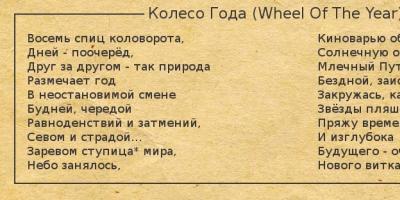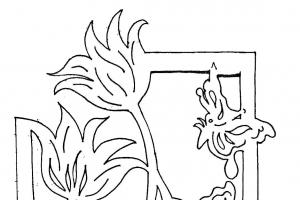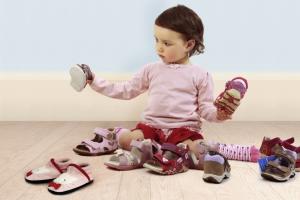Sliding folder for parents
Fairy tales in the life of a child


Target:
Involving parents in developing children's interest in books and reading fiction.
Content:
1. What is a fairy tale? The importance of reading for a child
2. How to read fairy tales to children
3. The benefits of reading to your child before bed
4. Didactic games for young children
7. Appendix 1

What is a fairy tale?
The importance of reading for a child
« A fairy tale is a seed, from which it sprouts
emotional assessment of the child
life phenomena»,
V.A. Sukhomlinsky
All children lovefairy tales. To the magical worldfairy talesthe child falls at a very early age. Listening to them, the baby, as if taking steps, comes tofairy taleand stays with her foreverlife.
The role of fairy talesin the development of children are multifaceted. Getting to knowfairy talehelps the child understand the surrounding reality. From the development of imagination to the development of correct speech, she teaches children in an accessible languagelife, talks about good and evil. Children understand more easilyfairy talethan adult speech. Children who were read to from early childhoodfairy tales, they begin to speak faster and express their thoughts correctly. Children'sfairy talesexpand vocabularybaby, speech becomes emotional, beautiful, figurative. A fairy tale helps to form the basis of behavior and communication.
Russian nationalfairy tales- This is the most popular and most beloved genre by children. They play bigrolein developing children's love for their native land.
It's not enough to just readfairy tale. In order for a child to remember it better, you need to help him understand it and experience various situations with the characters. When a child learns to work withfairy tale, will be able to navigate it well, analyze the actions of the heroes, he will be able to transfer this model to the real onelife, to correct some situation. And the time you spend with yourbaby, reading and playing is priceless.

One of the main conditions is the adult’s emotional attitude towards reading. Maintain eye contact with your child while reading. Sit down so that he can see your face and watch your facial expressions.
Shorten the text if it is too long,retellsome fragments in your own words, but do not go away from the contentfairy tales.
Readfairy tales alwayswhen the child wants to listen to them.
Unfamiliarfairy taleRead it yourself first to direct your child’s attention in the right direction.
Read to your child every day. Play out the impressions your child received while listening.fairy tales.
Remember! Watching a cartoon will never replace readingfairy tales. Cartoons are interesting to watch, but they do not develop imagination, because the action is presented on the screen. If you want your child to develop creatively, you need to give him room for imagination.

The benefits of reading to a child before bed
Reading to a child not only improves the relationship between the child and parents, but also develops his speech skills. Of course, it is correct and useful to read fairy tales at any time of the day. However, reading to a child at night brings many benefits.
Expanding vocabulary.Reading helps the child learn new words.
Speech development in children . It is important that parents read to the child clearly and pronounce the words correctly, in which case the child will develop correct pronunciation.
General development.While reading, the baby learns to listen, analyze, fantasize, he learns new words, and experiences various emotions. All this forms a harmonious personality.
Improving relationships with parents.When you read to your child, you spend time with him, the child feels important and feels your love.
Spiritual development of the child.Usually, parents read fairy tales to their children, which teach them the right actions, kindness, and responsibility. All this has a positive effect on the child’s spiritual development.
Healthy sleep.It often takes a long time to put children to bed, the reasons may be different - fear of staying in a dark room, excitement after active games. While reading, the child calms down; he is close to the parent, which gives him a feeling of security.

Didactic games
for young children
To make it easier for your child to remember fairy tales and then tell them, use didactic games. In addition, these games develop creative imagination, fantasy, and coherent speech.
"Sound engineers"
The game helps to develop oral coherent speech, to better remember the sequence of actions and the plot of a fairy tale. After reading the fairy tale, look at the illustrations for the fairy tale. Stop at the one you like. Let the child “voice out” the picture and remember how the characters speak. For example, a mouse squeaks: pee-pee-pee, a cockerel crows: ku-ka-re-ku, a frog croaks: qua-qua, and so on.
"Missed Frame"
The game helps the child remember the sequence of events of the fairy tale.
In order, pictures of the heroes of one of the fairy tales are laid out in front of the child. One picture is removed. The kid must remember who is missing. If it is difficult for him, you can put the upside down picture where it should be without disturbing the sequence. After voicing the missing plot, you need to tell the whole tale.


for children of early preschool age
Children of early preschool age need to be introduced to works of folk art. We recommend that you pay attention to the followingfairy tales:
"Turnip" arr. K. Ushinsky;
"Kolobok" arr. K. Ushinsky
“Rock-hen” arr. K. Ushinsky;
"Teremok" arr. M. Bulatova.


Tips for parents
Talk to your child more often about the value of the book.
Cultivate a caring attitude towards books.
You are the main example for your child, and if you want your child to read, then you should also spend some time with a book.
Visit the library and bookstores together.
Buy books that are bright in design and interesting in content.
Rejoice at your child’s successes, and don’t focus on mistakes.
Discuss the book you read among family members.
Tell your child about the author of the book you read.
Have family readings more often.
Reading for children should become a daily habit, a necessity.
By reading together, you open up an interesting and colorful literary world for your child. And remember, in this simple way you give your child a huge amount of happiness and love.

Arkady Markov
"True friend"
“A book comes to anyone’s home.
Touch its pages
She will talk to you
About the life of animals and birds.
You will see the rivers flooding,
You will hear the horse's tramp
Both Chuk and Gek will come to you,
Timur and Uncle Styopa..."

Annex 1
Illustrations for fairy tales

"Teremok"

"Turnip"

"Kolobok"

"Ryabka chicken"
No title
Older age
Educational goal: To expand children's awareness of themselves, their bodies, and their health. To contribute to the formation of ideas about the growth and development of man - a part of nature, a thinking being.
Topic: Forms of working with children; Objectives; Benefits;
Equipment
Structure of the human body Conversation “What am I made of?”
Experimentation:
In the pulp of the fruit of a watermelon or orange, see and distinguish individual cells. To help us realize that our entire body, all its parts, consist of countless tiny living cells. They breathe, feed, divide, constantly renew themselves, grow, and decay. Cell division diagrams.
Conversation “The skeleton is a reliable support for the human body” Prove by feeling your body that we consist of many large and small bones firmly attached to each other (skull, spine, rib cage). All together they make up the skeleton.. Model of the human skeleton
Excursion to the construction of a new house. Prove that the skeleton is a reliable support for the human body by comparing it with a strong house (before starting construction, people build a frame - a huge cage - a “skeleton”, and then strengthen the slabs of walls, ceilings, floors) Attributes for the s/r game “Builders”
Experimentation:
Consideration of the structure of tubular bone (chicken, ram, pig) and comparison with flat bone (rib, shoulder blade)
Excursion to the local history museum. Bring the children to the conclusion: due to the special structure of the bones, the human skeleton does not weigh that much. Focus children's attention on the fact that people who engage in sports and exercise develop better bones. They become stronger and thicker, since a strong person needs strong support. Album for consideration: “Can bones tell the story of long ago?”
S/r game “Traum Center” Tell that there are cases when people break an arm or leg. Then doctors connect the broken bones and apply plaster. At the fracture site, new bone cells begin to grow and the bone heals. Attributes for the s/r game “Traumpunkt”
Conversation “How a person moves”
Experimentation:
Measuring the thickness of the arm muscle in the shoulder (biceps) at rest and under tension. Familiarize children with what helps us make movements. The muscles contract, shorten, dragging the bones with them - this is how a person moves. Photos of people doing different sports.
Game “Muscle Training” To prove that our body has one amazing property - work is useful for it. The body always sends more blood to those cells that are working. They eat and grow better - that's why athletes train, i.e. perform exercises. Introduce children to some exercises. Album for consideration “How to become Hercules?”
Conversation: “Correct posture is the key to health.”
Experiment: teach children to determine correct posture by leaning against a wall (if the body is in the correct position, it should touch the wall with the back of the head, shoulder blades, buttocks and heels). Prove how bad posture is for your health. Incorrect posture not only disfigures the human body, but also greatly impedes the functioning of internal organs. The heart is in an abnormally compressed state, and its work is difficult. The lungs poorly supply the body with oxygen, the digestive organs are compressed. Incorrect posture can be corrected with special exercises, self-training, self-control, and exercise therapy. Game "Swallow"
Imagine yourself as a bird, standing on your right leg, bend your body to a horizontal position, take your left leg back, bend your back, arms to the sides, close your eyes. This exercise develops posture, plasticity, grace, and trains balance.
Sense organs. Leather. Experiment: examining skin through a magnifying glass on different parts of the body: on the tips of the fingers, on the palm, on the forehead. Conclusion: the skin on different parts of the body has different patterns.
Experiment:
With your eyes closed, try to determine the method of exposure to the skin:
Inject:
Pinch:
Draw a line with any object;
Apply ice or a hot object;
Drop water;
Swipe with a feather, etc. Talk about the importance of skin for a person:
Does not allow water to pass through;
Reliably protects internal organs from damage, taking shocks and blows, scratches and burns;
Protects us from heat and cold;
Helps us breathe - fresh air enters through its pores;
It produces droplets of sweat, which remove many harmful wastes from our body. The skin is very sensitive: it constantly tells us what is happening to our body - are we hot or cold, is something scratching us, is the wind blowing on us, is a mosquito landing on us? Diagram "What does our skin feel?"
Conversation in the “Generous Heat” sauna Convince children of the health benefits of the sauna and swimming pool: cleansing the skin, hardening the body, gymnastics for the blood vessels. Feel the surge of strength and energy after the bath. Sauna accessories.
Plot-didactic game “How to treat a wound on the skin” Referring to the personal experience of children, prove the need to treat cuts on the skin in order to avoid suppuration. Teach children to treat small wounds on the skin, help overcome their fear of iodine. Pieces of foam rubber with cuts in the form of a “wound”, matches without sulfur heads, cotton wool that children wrap around a match, vials of iodine or brilliant green.
Nose. Experimentation:
“How the nose smells” Determine what is in the box without looking and holding your nose, then inhaling through your nose.
Conclusion: When inhaling through the mouth, the smell is not felt; a person feels the smell only when he inhales through the nose. Find out what the nose is needed for (for breathing, for detecting odors). Noses help animals live:
The woodpecker uses its nose and beak to dig into trees, catching insects;
the swordfish pierces the fish with its terrible nose;
the wild boar digs the ground with its nose, pulling out edible roots;
The mosquito sucks blood with its needle nose;
clinging to its nose-beak, the parrot climbs trees;
Ostriches use their beaks to measure the temperature of the sand. "Kindersurprise" containers containing odorous substances.
Observing the habits of animals in nature. Talk about the sense of animals. The sense of smell serves animals to select and search for food and track prey. For animals, the most important thing is to smell the thing. When a horse is afraid of something, it snorts - it clears its nose to smell better. Dogs recognize each other and give each other signs by smell. Insects have the most subtle sense (a bee flies to a flower, a worm crawls to a leaf, a mosquito smells a person) Board game “Who feels what”
Organ of taste. Experimentation:
Practice identifying the sensations of taste, proving the need for saliva for the sensation of taste. Conclusion: the tongue is an organ of taste.
Experimentation:
Hold your tongue between your teeth and try to say something. Conclusion: the tongue is an organ of speech. Determine the taste zones of the tongue. Sweet and salty are determined by the tip of the tongue, sour by the sides, and bitter by the root. Focus on how best to place a bitter pill on the tongue. Schematic representation of the taste zones of the tongue.
Illustrations showing the role of language for animals:
hunter tongue (chameleon, frog, anteater);
tongue-spoon (animals lap);
tongue-fan (dogs, foxes, wolves cool their body).
Organ of vision. Experimentation:
Looking at your eyes in the mirror. Determine the meaning of parts of the eye (eyelids, eyelashes) - protection from sweat, dust, wind.
To encourage children to understand that vision is a priceless gift of nature that must be protected. The eye distinguishes the finest shades of colors, the smallest sizes, sees well during the day and quite well at dusk. If you close your eyes, you will find yourself in the dark. Tell that some animals (owls, dogs, mice) see everything around them not in color, but in black and white. Turtle - only in green. A frog's eyes see only what moves. A kite from a great height can see a small chicken on the ground. Game "Who can name the most colors and shades of color."
Rules in pictures:
Watch TV from a distance of at least 3m;
Wash your face with soap every day;
Do not rub your eyes with dirty hands.
Role-playing game "Vision Test" Tell children why and why some people wear glasses. Talk about the problems of blind people. Try to guess some objects and letters by touch. Attributes for the s/r game "Ophthalmologist's Office"
Didactic game "Wonderful bag"
Exercises for the eyes “Scary Stories” (move to the side, blink, rotate to make it scary, close).
“Bee” (focus your gaze on an imaginary moving bee and perform circular movements with your eyes) Promote the habit of regularly doing exercises to relax your eyes. Exercise schemes for resting the eyes
Organs of hearing. Conversation "Why do I hear"
Experimentation:
“Let’s check your hearing” Determine approximately at what distance a person can hear. Show how a person hears sound. To acquaint children with the peculiarities of human hearing development and with the various causes of its impairment. Develop auditory attention. Didactic game “What is good for the ears” (pictures with useful and harmful situations for the ears)
Game "Find out by ear"
Productive activities:
Making a volume scale. Prove that loud sounds cause strong vibrations of the eardrum, which can lead to hearing loss. Suggest constructing a sound strength and volume meter. Illustration album “Who Hears How” (An owl catches its prey by ear at night, the owl’s ears are under its feathers. The moth hears with its mustache. The locust hears with its belly. The grasshopper’s auditory fossae are on the leg. The fish’s hearing organ is the swim bladder. The fox hears mice under the snow. The sea jellyfish hears the approaching storm 15 hours before).
In a healthy body healthy mind! Conversation “Why hardening is needed” To promote the understanding that strength and endurance are not born with a person, but are developed by him. Even a naturally weak person can become strong and resilient. (story about the Russian commander A. Suvorov) Rules and secrets of hardening in pictures:
Dress for the weather, do not bundle up;
Do exercises;
Wipe off with a damp towel;
Take a shower daily;
Move more, play outdoor games, run.
Gymnastics “Health Points” To promote the development of the habit of performing massage daily in the morning and evening. To consolidate knowledge about certain vital centers on the human body. Exposure to them through acupressure helps protect against colds and other diseases. Schematic representation of health points on the human body.
Exhibition "Green Pharmacy" Introduce children to the most common medicinal plants - sources of life and health. Give children the concept of “herbal medicine” Didactic games “Listen and remember” (medicinal properties of birch, lingonberry, St. John’s wort, calendula, nettle, linden, lemon, onion, coltsfoot, dandelion, plantain, chamomile, etc.)
"Guess a riddle",
"Getting to know medicinal plants"
Poem by P. Sinyavsky "Green Pharmacy"
Conversation “Vitamins and healthy foods” Explain to children that vitamins are necessary for normal human growth and development. They increase the body's resistance to colds. Vitamins can only come from food; the body itself does not produce them. "10 little secrets of healthy eating" (in pictures)
Game “What vitamin is in these products” Tell children the story of the discovery of vitamins by the Polish scientist Funk. Introduce the designation of the names of vitamins in Latin letters A, B, C, etc. An album with images of products containing certain vitamins.
Competition “My Favorite Dish” To promote understanding that the healthiest food is the one that a person eats with appetite. Food should be varied and tasty and consist of products of plant and animal origin. Illustration magazine "From food - food", "Amazing tastes of different peoples"
From the animal world:
The earthworm eats the earth;
Mol - clothes;
A predatory plant, the sundew absorbs insects.
Conversation "Sport! Sports! Sports!" To promote in children the formation of healthy lifestyle values: playing sports is very beneficial for human health. Illustration magazine "Choose to taste" (sports)
Productive activity: Construction from waste material “Items necessary for various sports” Develop the ability to see the possibilities of transforming objects, participate in collective transformation, realize your creative potential. Didactic game "Who needs what?"
(items necessary for practicing one or another sport)
"Olympic" games Organize the educational space of the group so that each child can choose a sport that he likes and suits his body, age, character. Material about the winners of the Olympic Games in different sports
Description of the presentation by individual slides:
1 slide
Slide description:
2 slide
Slide description:
Why do children need fairy tales? The most traditional are folk tales, passed down from generation to generation, but remaining virtually unchanged. The beauty of a fairy tale is that it always has a good ending. And this, in turn, gives us unshakable confidence that good always triumphs over evil, that bad deeds are punishable, one way or another, and we should never give up in the face of difficulties in life. A child lives through a fairy tale fragments of the life of his favorite characters. Thus, it is as if he is programmed for certain actions in similar situations in his life. Through a fairy tale, it is easier and more clear to explain to a child the common truths: do not offend the weak, do not deceive, be kind and responsive to the sorrows of others, do not be a simpleton and be able to recognize deception and intentions to harm you.
3 slide
Slide description:
Listening to fairy tales, the child experiences pleasure, this is a kind of entertainment, in addition, the fairy tale makes the child think, use his imagination and imagination. At the same time, there is no direct moral teaching in the fairy tale; the fairy tale teaches, but not intrusively. For older children, you can regularly use this game: we read a fairy tale, stop before the ending and invite the child to come up with the ending himself. You can play in this way with the same fairy tale as many times as you like until the child’s interest in the process dries up. This method is widely used in fairy tale therapy; in addition, psychologists often recommend giving the child the opportunity to come up with a fairy tale, in which the characters can sometimes commit very illogical, sometimes incorrect, in the opinion of parents, actions.
4 slide
Slide description:
Reading a fairy tale for the hundredth time... Parents who practice reading bedtime stories have probably already encountered the phenomenon of a child demanding to read the same fairy tale many evenings in a row. What is this connected with and is it necessary to fight it? Psychologists explain this by two factors. Firstly, the child’s brain is designed in such a way that first he remembers information, learns it by heart, and then understanding and awareness of this information comes. As a rule, a fairy tale contains a chain of events, but it seems to us, adults, that everything is presented in an accessible way in the book. But in reality, it is difficult for a child to digest the entire fairy tale in one listen, so there is a need to listen to it and listen. In addition, the child has a need for stability and rituals. He has already listened to the fairy tale, remembers the ending, and thus the child develops a feeling of confidence, protection, he has, as it were, protected himself from unexpected events. And, of course, there is no need to fight this, but rather, on the contrary, with all actions to support the child’s attachment to a specific fairy tale.
5 slide
Slide description:
Discussion of a read fairy tale We should not forget about the need to discuss a read fairy tale. Even if it seems that the child understands everything, it is better to discuss the fairy tale once again, making sure that the child understood everything correctly, did not distort the attitude towards the actions of the characters, and was able to figure out where they did the right thing and what is an example of negative actions. Through discussion, you can reveal the child’s hidden fears of certain characters from a fairy tale or from the child’s everyday life. Choosing the right fairy tales for your child A fairy tale must be selected depending on the child’s age and possible characteristics of psychological development. From the age of two, children prefer fairy tales with cyclically repeating events, as, for example, in the fairy tales “Teremok”, “Kolobok”, “Turnip”. Fairy tales with animal characters are best learned; the child loves to repeat sounds that imitate the characters in the fairy tale.
6 slide
Slide description:
From two to five years of age, the child’s ability to imagine actively develops. During this period, it is favorable to use the game mentioned above - the child himself comes up with the ending of the fairy tale. During this period, the child should buy fairy tales about magic, which he will definitely like. From five to seven years old, as a rule, a child is interested in fairy tales with dynamic plots and adventure literature. At this age, you should ask the child himself about his preferences in literature, choose heroes close to his liking, there is no need to impose your preferences. A child who regularly listens or reads fairy tales grows up more mature, filled with sensual, emotional, and comprehensive development. Childhood is fertile ground for sowing parental attention. Good fairy tales to you and your children!
Folder "The role of fairy tales in the development and upbringing of a child"
Anastasia Aleksandrovna Geraseva, teacher of the Child Development Center - Kindergarten "Luchik", Michurinsk.Description of material: the material is addressed to preschool teachers, specialist teachers, and parents.
Purpose: This mobile folder can be used to design a group, as a visual material for parents.
Target: increasing the competence of parents regarding the role of fairy tales in the development and upbringing of a child.
Tasks: to introduce parents to didactic games based on fairy tales and fairy tale therapy techniques for raising a child.
The pages of the folder contain arguments about the importance of fairy tales for the development and upbringing of children, examples of didactic games aimed at developing the child’s memory and imagination, useful tips for parents on dealing with children’s whims and disobedience with the help of fairy tale therapy.
Fairy tales are a unique cultural heritage that can console, help in understanding the world around us and ourselves, and teach the rules of life.
Having learned to work with a fairy tale, the child will analyze and evaluate the actions of the characters, will be able to transfer the behavior model into real life or correct any problematic situation.
Fairy tales develop children's imaginative and logical thinking, their creative abilities, speech, introduce children to the natural world and help in preparing them for school.
Page No. 1: Title page.
Page #2:
Children draw many first ideas from fairy tales: about time and space, about the connection of man with nature, with the objective world; fairy tales allow children to see good and evil.
Listening to fairy tales, kids empathize with the characters, they have an impulse to assist, to help, to protect.
In preschool age, the perception of a fairy tale becomes a specific activity of the child, allowing him to freely dream and fantasize.
The role of fairy tales in the development of correct oral speech cannot be denied - texts expand a child’s vocabulary, help construct dialogues correctly, and influence the development of coherent speech. But in addition to all these, albeit key, tasks, it is no less important to make our oral and written speech emotional, imaginative and beautiful.
It's not enough to just read a fairy tale. In order for a child to remember it better, you need to help him understand it and experience various situations with the characters. Analyze the actions of the heroes, imagine yourself in their place. Then the memorization will be conscious and deep.

Page #3:
To make it easier for your child to remember fairy tales and then tell them, use didactic games. In addition, these games develop creative imagination, fantasy, and coherent speech.
"Meetings of Heroes"
The game develops oral dialogic speech, helps to remember the sequence of actions and the plot of a fairy tale.
After reading, offer your child images of two characters from it. The child’s task is to remember what the characters said to each other. You can suggest heroes who are not found in the fairy tale. For example, in the fairy tale “Kolobok” the hare and the bear do not meet each other. But what did they say to each other when they met? Did you praise Kolobok for his ingenuity or complain to each other about the deceiver?
"Sound engineers"
The game helps to develop oral coherent speech, to better remember the sequence of actions and the plot of a fairy tale.
After reading the fairy tale, look at the illustrations for the fairy tale. Stop at the one you like. Let the child “voice out” the picture, remember what the characters said at that moment, what they did. You can also use fragments of cartoons based on fairy tales. Turn off the sound and let your child verbalize the events.
"New Tales"
Goal: development of creative imagination, fantasy, coherent speech.
Remember the sequence of events in a familiar fairy tale, clarify where the action takes place, which characters are encountered. And suddenly something became different in the fairy tale: the scene of action changed, a new hero appeared. For example, in the fairy tale “Turnip” we will change the scene and send the heroes from the garden to the stadium. What happens if an evil witch or sparrow also appears there? There are many options.
"Missed Frame"
Goal: to teach how to compose a story based on a series of plot pictures, to help the child remember the sequence of events of the fairy tale.
Pictures of one of the fairy tales are placed in order in front of the child. One picture is removed. The kid must remember which plot was missed. If it is difficult for him, you can put the upside down picture where it should be without disturbing the sequence. After voicing the missing plot, you need to tell the whole tale.

Page #4:
Fairy tales will help you cope with children's disobedience!
Children's whims... All parents have encountered them at least once. The child does not put away his toys, refuses to eat or go to bed, does not want to go to kindergarten, takes what belongs to others or fights with other children, throws tantrums - such problems are very common.
Often persuasion, shouting, and long moralizing are of no use. Much has been said about the dangers of assault, and many have probably been convinced more than once of the ineffectiveness of such methods. What to do? There is a simple but effective method of dealing with children's whims. Try not to scold the child, do not punish him with your inattention, but tell him a fairy tale. These are special psychological fairy tales that help cope with most of the child’s whims. In these fairy tales, the child sees heroes who face the same problems as him, and the child begins to understand how to get out of a difficult situation.
The effect of joint creativity will not take long to arrive. You will not only understand each other better, but also fill your communication with joy and inspiration. The priceless time you spend with your child reading a fairy tale cannot be replaced by any other benefits.

Thank you for your attention!








